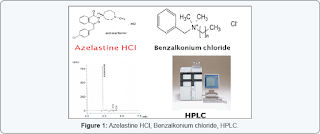Simultaneous Determination of Azelastine hydrochloride and Benzalkonium chloride by RP-HPLC Method in their Ophthalmic Solution by MEM Hassouna in JFSCI - Juniper Publishers
Azelastine hydrochloride (AZH); is chemically known as 4-(4-Chlorobenzyl)-2- [(4RS)-1-methylhexahydro-1H-azepin- 4-yl] phthalazin-1(2H)-one hydrochloride [1,2]. AZH occurs as a white or almost white, crystalline powder. AZH is a potent, second generation, selective, histamine antagonist (histamine- H1-receptor antagonist) used as first line therapy of mild J Forensic Sci & Criminal Inves 1(3): JFSCI.MS.ID.555565 (2017) intermittent, moderate/severe intermittent and mild persistent rhinitis (new classification system for rhinitis). AZH has been formulated both as a nasal spray and as eye drops. Azelastine eye drops are indicated for the local treatment of seasonal and perennial allergic conjunctivitis [3,4]. Benzalkonium chloride (BAC); chemically known as mixture of alkylbenzyldimethyl ammonium chlorides, the alkyl groups mainly having chain lengths of C12, C14 and C16. [1,2]. BAC is a frequently used preservative in eye drops; typical concentrations range from 0.004% to 0.01%. Stronger concentrations can be caustic and cause irreversible damage to the corneal endothelium [5]. Azelastine hydrochloride is official in British Pharmacopeia (BP) [1] and European Pharmacopeia (EP) [6], both of them includes potentiometric titration for estimation of AZH. BAC is official in BP [1], EP [6] and United States Pharmacopeia (USP) [7], which include potentiometric titration and HPLC method for its estimation. The combination of these two drugs is not official in any pharmacopoeia.





No comments:
Post a Comment